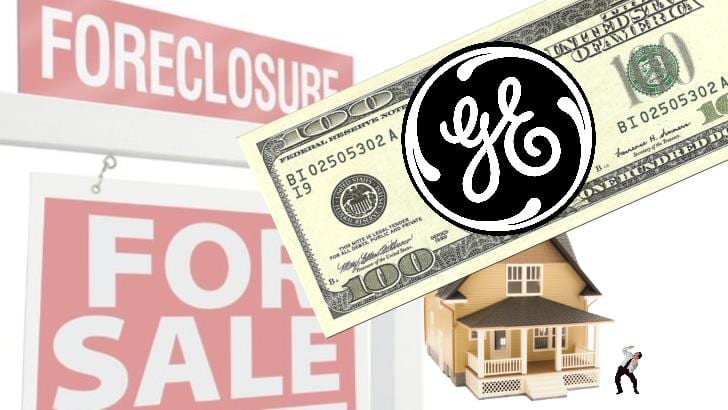
Image by Kent Buckley
February 15, 2016
BY JASON PRAMAS @JASONPRAMAS
Returning to our ongoing look at General Electric’s recent and inconvenient history of violating the public trust, in part 2 of this “missing manual” the corporation got out of the subprime housing loan market just in time to avoid destruction in late 2007. But it could not escape from the consequences of an economy based on selling toxic home loans to poor people who were defaulting in vast numbers by 2008.
That year, everything began to unravel for GE—as it did for all other large interlocked financial services companies that derived a substantial percentage of their profits from predatory loans in the same period.
According to Fortune magazine, after reporting an unprecedented first quarter loss of $700 million, GE’s stock price began spiraling downwards in April 2008. Failing to sell off its light bulb, appliance, and private-label credit card businesses over the summer due to the worsening economic climate stopped the corporation from making typical course corrections to get back on its feet.
In September 2008, GE’s stock price crashed after Lehman Brothers—a financial services titan—collapsed on the heels of Bear Stearns’ disintegration that March. The company became starved for operating funds. But the private credit markets were frozen in terror.
On September 30, GE made two desperate moves. At 7:30 am it sold $3 billion in preferred stock to billionaire investor Warren Buffet’s Berkshire Hathaway Inc. on very bad terms. At 1:44 pm, GE announced its deal with Buffet and said it would sell $12 billion of common stock the next day at prices far lower than it had paid to buy back $15 billion of its own stock over the preceding year. Meaning it was selling the stock at a huge loss in exchange for ready cash.
The next day, the coup de grace: Word spread throughout the markets that GE would be unable to cover billions in regular payouts to holders of its commercial paper. Basically a kind of I.O.U., commercial paper is a kind of short-term promissory note that big corporations like GE are able to issue on an ongoing basis to raise money to cover things like daily expenses. There is no collateral behind commercial paper. Only the good name—and, ideally, top-flight credit rating—of the company issuing it. In normal times, it’s a far cheaper way to borrow money than a line of credit with a commercial bank. But 2008 was not a normal time. At one point that year, GE had over $100 billion dollars out in commercial paper as it tried to stay afloat.
Executives clearly knew their company was doomed unless the government bailed it out. Already on September 30, a GE spokesperson “e-mailed the media with a message that Congress must act ‘urgently’ on the pending financial bailout package.” But the company didn’t wait for congressional action. Since it was not a traditional bank, GE did not qualify for a significant direct cash infusion under the infamousTroubled Asset Relief Program (TARP). So it spent the next few weeks brokering a backroom deal with the Federal Deposit Insurance Corporation (FDIC).
According to the New York Times, on November 12, 2008 the FDIC announced that it would back GE’s commercial paper for up to $139 billion under the Temporary Liquidity Guarantee Program (TLGP). A program that the federal government changed overnight to allow GE to qualify—just as TARP was changed to benefit Goldman Sachs et al—according to Pro Publica and the Washington Post. GE had “joined major banks collectively saving billions of dollars by raising money for their operations at lower interest rates.” The company was able to sell $74 billion in government-backed commercial paper and longer-term notes by Spring 2009.
And how did GE survive the period between its early October 2008 financial collapse—when it was still short on funds despite the precipitous sale of $15 billion of its stock—and its November 2008 bailout by the TLGP program? In 2010, Pro Publica reported that Federal Reserve Board documents released that year showed that GE had effectively borrowed $16 billion more dollars at that time by selling commercial paper through the Fed’s Commercial Paper Funding Facility (CPFF).
So General Electric was saved by two government programs that provided it with upwards of $90 billion dollars of cheap credit. According to the corporation’s own September 30, 2009 10-Q filing to the Securities and Exchange Commission, GE paid only $2.3 billion in fees for its participation in the TLGP and CPFF programs. Meaning that GE got unbelievably good loan terms—the equivalent of a flat 2.56 percent interest rate. Less than the rates that Americans pay on most any other loans. Including the housing loans that wrecked the economy in 2007-2008. And the student loans that could very well lead to another financial catastrophe before this decade is out.
That is how GE got to survive the recession it helped create. By gaining access to a massive pool of public funds totally unavailable to its tens of thousands of subprime housing loan victims. The same company under the same leadership that Massachusetts officials are paying $270 million to bring to Boston. Excelsior!
Coming soon in part 4: GE’s municipal bond scandal and other amusements.
Apparent Horizon is syndicated by the Boston Institute for Nonprofit Journalism. Jason Pramas is BINJ’s network director.
Copyright 2016 Jason Pramas. Licensed for use by the Boston Institute for Nonprofit Journalism and media outlets in its network.


